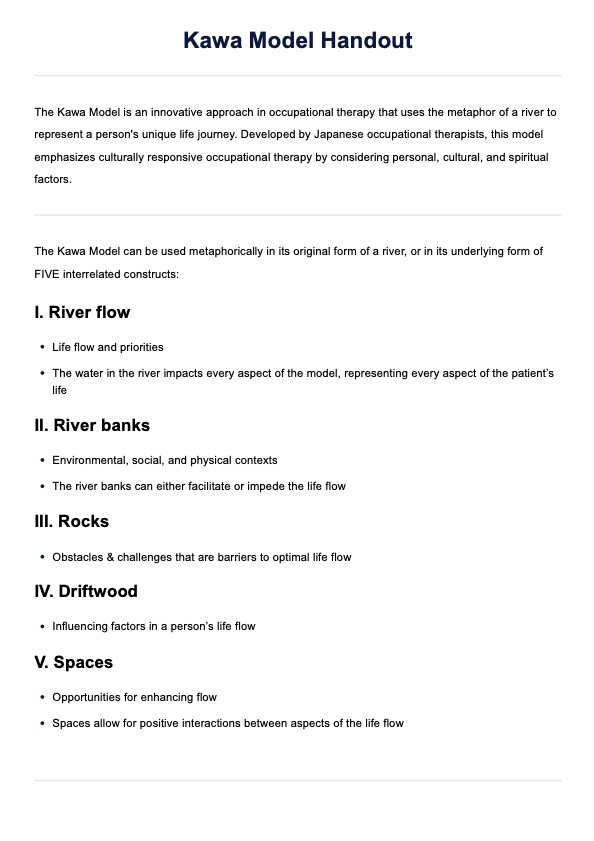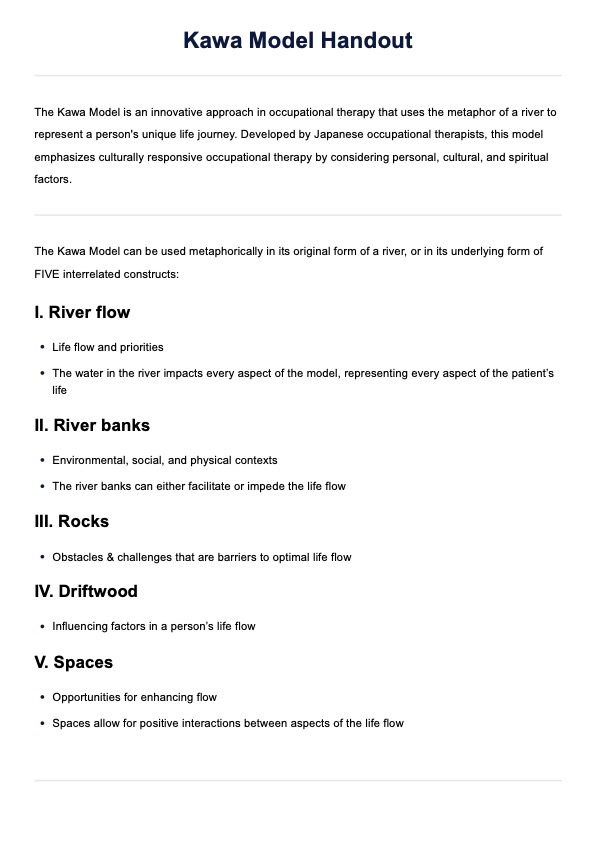Kawa Model
Download Carepatron's free PDF handout and example of the Kawa Model, a holistic occupational therapy method for understanding a person's life flow and challenges.


What is the kawa model?
The Kawa Model is an innovative approach in occupational therapy that uses the metaphor of a river to represent a person's unique life journey. Developed by Japanese occupational therapists, this model emphasizes culturally responsive occupational therapy by considering personal, cultural, and spiritual factors. The river's flow symbolizes life flow and well-being, while obstacles and driftwood represent challenges and personal factors affecting a person's life. Using the Kawa Model, therapists can better understand how environmental factors influence occupational performance and mental health, enabling more personalized and effective interventions.
Components of the Kawa Model
The Kawa Model consists of several key components that collectively illustrate a person's life journey. The river itself represents the flow of life, where life flow and well-being are depicted by the water's movement. Obstacles in the river, such as rocks, signify challenges or life events that hinder occupational performance. Driftwood represents personal factors, including skills and values, which can either obstruct or aid the flow. The riverbanks symbolize environmental factors and social contexts shaping the person's life.
Kawa Model Template
Kawa Model Example
Applications of the Kawa Model in medical practice
The Kawa Model offers valuable applications in medical practice, particularly in the field of occupational therapy. This model serves as a framework for guiding the assessment and intervention processes by focusing on a person's occupational history, current performance, and future goals. By visualizing a person's life as a river, the Kawa Model helps occupational therapists understand the harmony between individuals and their environmental factors, which is essential for enhancing well-being.
In clinical settings, the Kawa Model enables therapists to comprehensively evaluate their clients' contexts, including personal, cultural, and environmental factors. This understanding allows therapists to identify and prioritize problems that obstruct the flow of life, such as physical disabilities, mental health issues, or social challenges. By addressing these obstacles through targeted interventions, therapists can facilitate improved occupational performance and overall well-being.
The model's emphasis on harmony between the person and their environment encourages a holistic approach to therapy, ensuring that interventions are culturally responsive and tailored to the individual's unique life journey.
How to use our Kawa Model handout template
Our Kawa Model handout template is designed to help occupational therapists engage their patients in a meaningful therapeutic process. The template serves as a guide for introducing and explaining the Kawa Model to patients, ensuring a clear understanding of its components and applications. Follow these steps to maximize the benefits of our Kawa Model handout template.
Access the handout
To access the Kawa Model handout template, download the PDF version from this page.
Review the handout
Before presenting the handout to your patients, take the time to thoroughly review its contents. Familiarize yourself with the key components and explanations provided within the template. This will prepare you to effectively convey the information and answer any questions your patients may have.
Introduce the handout to the patient
When introducing the handout to your patient, provide an overview of the Kawa Model and its relevance to their treatment. Explain how the model uses the metaphor of a river to represent their life journey and the importance of understanding personal, cultural, and environmental factors in their therapy.
Complete the river flow with your patient
Guide your patient through the template, highlighting how it can help identify obstacles and strengths in their life. Encourage them to reflect on their own experiences and, together, complete the drawing of the river flow. Work with your patient to identify opportunities for development and improvement and use these to form the basis of interventions going forward.
Reassess your patient's river flow
After a set period of time, you should revisit the Kawa model with your patient and identify changes in their life flow. This will provide you with a more holistic understanding of your patient's well being and enable you to continue meaningful and informed treatment.
How can occupational therapists benefit from our template?
Our Kawa Model handout template provides several key benefits for occupational therapists, enhancing their occupational therapy practice and patient outcomes. Here are three primary advantages:
Enhances culturally sensitive interventions
The Kawa Model handout supports culturally sensitive occupational therapy by incorporating cultural factors and recognizing the unique contexts in which a person exists. This understanding helps therapists develop interventions that respect and align with the patient's cultural background, leading to more effective and personalized care.
Provides a clear visual representation
Using the metaphor of a river, our template offers a clear visual representation of a patient's life journey, including the riverbanks and obstacles they face. This helps in visualizing external factors affecting occupational engagement and well-being. By facilitating communication and self-awareness, therapists and patients can better understand and address these elements during the intervention process.
Facilitates communication and interaction
The Kawa Model handout aids in developing interactions and communication between therapists and patients. By providing a structured yet flexible framework, the handout encourages discussions about personal and external factors influencing the patient's life. This collaborative approach not only enhances self-awareness but also strengthens the therapeutic alliance, improving outcomes in occupational therapy and allied health sciences.
Commonly asked questions
The Kawa Model, developed by Japanese occupational therapists, uses the metaphor of a river to represent an individual's life journey. "Kawa" means "river" in Japanese, symbolizing the flow of life and well-being.
The Kawa Model of the occupational therapy process involves assessing and addressing personal, cultural, and environmental factors that influence a person's life. This model helps therapists create culturally sensitive and personalized interventions to enhance occupational performance and well-being.
The Kawa Model of goal setting focuses on identifying and overcoming obstacles in the individual's life flow. Therapists and patients collaborate to set realistic and meaningful goals that improve occupational engagement and quality of life.
The Model of Human Occupation (Moho) emphasizes the dynamic interaction between a person, their environment, and their occupations. In contrast, the Kawa Model uses the metaphor of a river to illustrate a person's life journey, focusing on cultural and environmental factors affecting occupational performance.





















-template.jpg)


















































































